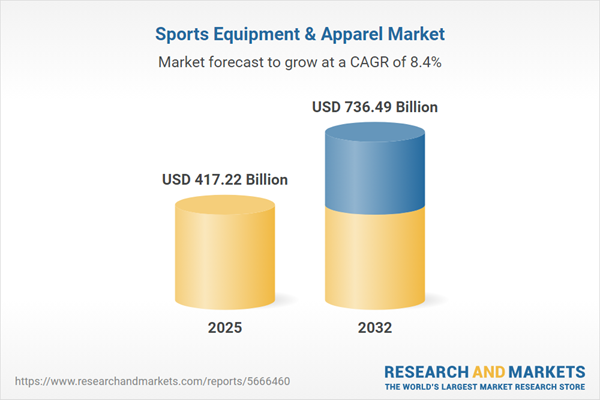Speak directly to the analyst to clarify any post sales queries you may have.
The sports equipment and apparel market is undergoing significant transformation, driven by rapid innovation, shifting consumer preferences, and ongoing changes in distribution models. Senior leaders require clarity on the market’s evolving drivers and actionable frameworks to maintain agility and competitiveness.
Market Snapshot: Sports Equipment & Apparel Market
The global sports equipment and apparel market grew from USD 386.53 billion in 2024 to USD 417.22 billion in 2025 and is forecast to reach USD 736.49 billion by 2032, driven by a CAGR of 8.39%. This growth is propelled by consumer focus on health and wellness, the adoption of digital sales channels, and intensifying focus on sustainability and technology integration. Evolving consumer demand shapes product development around performance, comfort, and eco-friendly materials, while digital and omnichannel commerce environments continue to streamline access and choice for buyers.
Scope & Segmentation of the Sports Equipment and Apparel Market
This report provides a comprehensive analysis of the primary market segments, offering in-depth perspectives on product innovations, end-user habits, and the evolving technological landscape. Segmentation covers:
- Product Type: Apparel (including bottoms, compression wear, jackets & hoodies, socks & accessories, sports bras, swimwear, tops & T-shirts); Equipment (balls, bats, sticks & clubs, fitness equipment, footwear, nets & goals, protective gear, rackets).
- Sport Type: Adventure sports (paragliding, rock climbing, surfing), fitness activities (aerobics, CrossFit, yoga), individual sports (badminton, golf, tennis), team sports (basketball, rugby, soccer).
- Material Type: Natural materials (cotton, wool); synthetic materials (nylon, polyester).
- End User: Kids, men, women, unisex.
- Distribution Channel: Offline, online.
- Geographies Covered: Americas (North America, Latin America), Europe (including UK, Germany, France, Russia, Italy, Spain, Netherlands, Sweden, Poland, Switzerland), Middle East (UAE, Saudi Arabia, Qatar, Turkey, Israel), Africa (South Africa, Nigeria, Egypt, Kenya), and Asia-Pacific (China, India, Japan, Australia, South Korea, Indonesia, Thailand, Malaysia, Singapore, Taiwan).
- Company Coverage: Market leaders and innovators such as Adidas AG, NIKE, Inc., Puma SE, ASICS Corporation, V.F. Corporation, Under Armour, Inc., Decathlon Group, Amer Sports, Inc., YONEX Co., Ltd., and others.
Key Takeaways for Senior Decision-Makers
- Health and wellness trends are reshaping both product innovation and marketing, with increased demand for versatile, sustainable gear and performance-based designs.
- Digital channels—including mobile commerce and omnichannel strategies—are expanding reach and enabling more personalized consumer engagement.
- Environmental sustainability initiatives, such as the adoption of circular economy models and eco-friendly materials, are becoming pivotal in supply chain and product strategies.
- Technological advancements (smart textiles, sensors, AI-driven analytics) support high-precision customization and performance monitoring, empowering brands to enhance competitive differentiation.
- Regional markets demonstrate distinct growth drivers and challenges, with Asia-Pacific exhibiting accelerated adoption due to youth-focused demographics and infrastructure investment, while Europe emphasizes premium and sustainable offerings.
- Strategic partnerships, collaborations with technology firms, and athlete co-creation accelerate product development and expand access to new consumer groups.
Tariff Impact: Navigating US Trade Policy Changes
Recent US tariff revisions have increased import duties on select apparel and equipment categories, affecting landed costs and prompting a shift in sourcing and supply chain strategies. Companies are diversifying supplier networks, accelerating nearshoring, and utilizing free trade zones to buffer these impacts. The emphasis on adaptable procurement and compliance mechanisms continues to be a crucial factor for competitive positioning.
Methodology & Data Sources
This study employs a mixed-methods approach. Primary data was collected from executive interviews with industry leaders, designers, and retail managers, while secondary sources included industry group reports, filings, and public company disclosures. Analytical tools such as Porter's Five Forces, SWOT, and PESTEL frameworks underpin the segmentation and scenario planning. Comprehensive validation measures, including data triangulation and expert peer reviews, reinforce data integrity.
Why This Report Matters
- Informs market leaders with a roadmap for digital, supply chain, and product innovation tailored to evolving consumer and regulatory landscapes.
- Equips decision-makers with regionally nuanced strategies, operational benchmarks, and adaptive planning tools necessary for growth and resilience.
- Supports actionable allocation of resources across technology adoption, market entry planning, and risk mitigation.
Conclusion
To achieve sustained leadership in the sports equipment and apparel sector, organizations must prioritize digital integration, build resilient supply chains, and innovate in line with consumer and regulatory trends. This report offers executives the insights required for agile and strategic growth in a complex and fast-changing global market environment.
Additional Product Information:
- Purchase of this report includes 1 year online access with quarterly updates.
- This report can be updated on request. Please contact our Customer Experience team using the Ask a Question widget on our website.
Table of Contents
3. Executive Summary
4. Market Overview
7. Cumulative Impact of Artificial Intelligence 2025
Companies Mentioned
The companies profiled in this Sports Equipment & Apparel market report include:- Achilles Corporation
- Adidas AG
- Amer Sports, Inc.
- Anta Sports Products Limited
- ASICS Corporation
- Callaway Golf Co.
- Decathlon Group
- Descente Ltd.
- Easton Sports, Inc.
- FILA Holdings Corp.
- Freewill Sports Pvt Ltd
- Mizuno Corporation
- New Balance Athletics, Inc.
- NIKE, Inc.
- NISHOHI
- Puma SE
- Reebok International Ltd.
- Salvatore Ferragamo S.p.A.
- Shimano Inc.
- Skechers USA, Inc.
- Sports Direct International PLC
- Sumitomo Rubber Industries Limited
- Under Armour, Inc.
- UNIQLO Co., Ltd.
- V.F. Corporation
- YONEX Co., Ltd.
Table Information
| Report Attribute | Details |
|---|---|
| No. of Pages | 181 |
| Published | November 2025 |
| Forecast Period | 2025 - 2032 |
| Estimated Market Value ( USD | $ 417.22 Billion |
| Forecasted Market Value ( USD | $ 736.49 Billion |
| Compound Annual Growth Rate | 8.3% |
| Regions Covered | Global |
| No. of Companies Mentioned | 27 |









